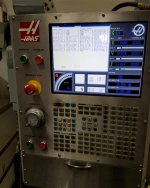Volitan
Hot Rolled
- Joined
- Sep 16, 2006
- Location
- Long Island, New York
I have to engrave engrave different letters on a few hundred different parts and was hoping to do it from user input.
These have to be pocketed out though, due to their size and complexity, and the customers wants with the font. The parts are all the same but the letters make each one a "one off"
Examples would be something like H29 or F100 or 2B....
I was hoping to have a sub to pocket each character, I can figure out the spacing, and have the operator punch in the number she needs for each piece. I'm stuck on how to do it from the operator punching the numbers in.
M109 seemed like a good bet, but on our control (a 2007 with version M15.xx software) it seems like it only takes one letter?
Is there a way maybe to "hack" into the G47 engraving cycle and point each letter to my own subprograms maybe?
We have an older Haas with an upgraded M17.xx control if that makes a difference. Didn't want to do it on that machine but I can.
These have to be pocketed out though, due to their size and complexity, and the customers wants with the font. The parts are all the same but the letters make each one a "one off"
Examples would be something like H29 or F100 or 2B....
I was hoping to have a sub to pocket each character, I can figure out the spacing, and have the operator punch in the number she needs for each piece. I'm stuck on how to do it from the operator punching the numbers in.
M109 seemed like a good bet, but on our control (a 2007 with version M15.xx software) it seems like it only takes one letter?
Is there a way maybe to "hack" into the G47 engraving cycle and point each letter to my own subprograms maybe?
We have an older Haas with an upgraded M17.xx control if that makes a difference. Didn't want to do it on that machine but I can.
Last edited:


